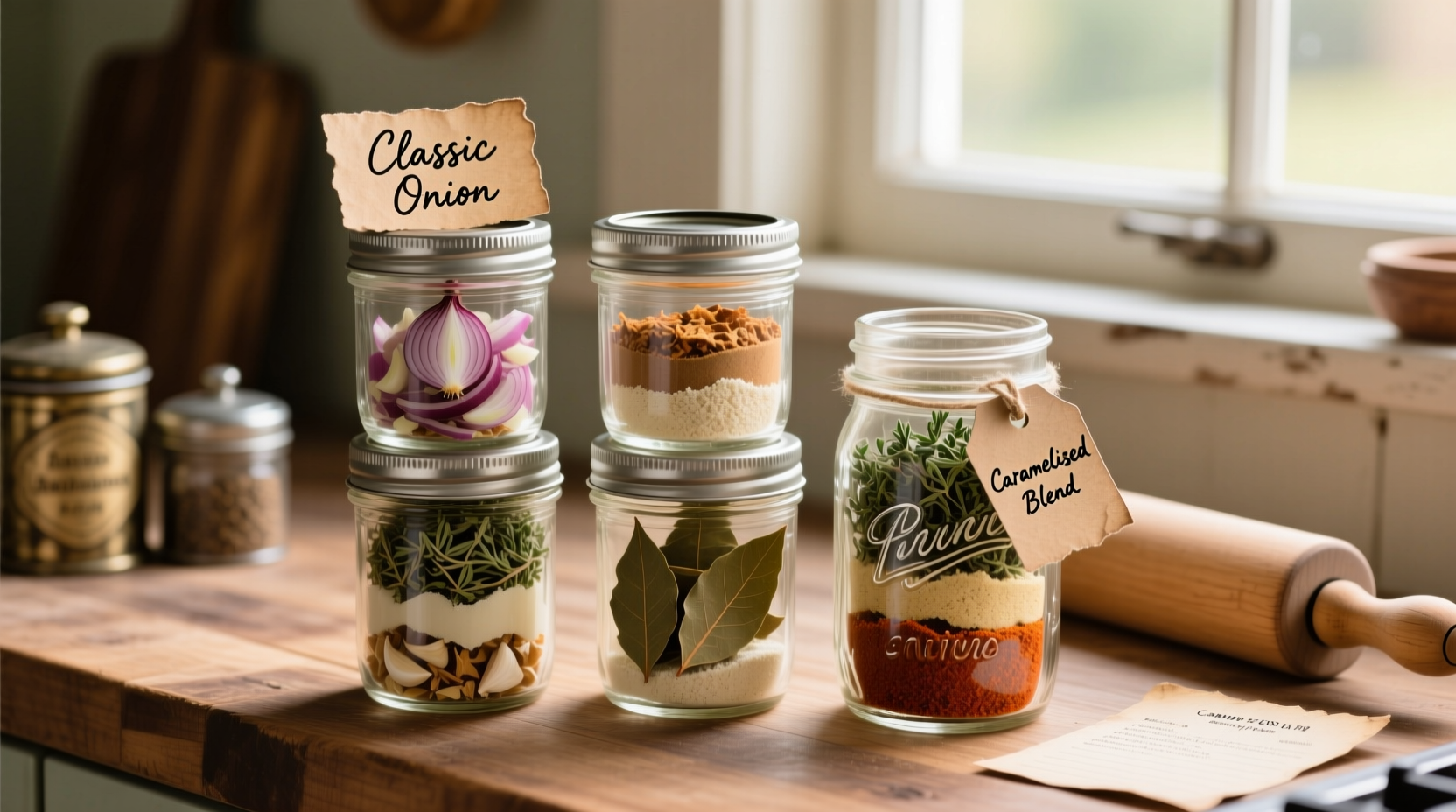If you need a substitute for dry onion soup mix, the best homemade alternative combines 2 tablespoons dried minced onion, 1 teaspoon beef bouillon powder, 1 teaspoon onion powder, 1 teaspoon garlic powder, 1/2 teaspoon parsley flakes, and a pinch each of celery salt, paprika, and black pepper. This blend perfectly replicates the savory umami flavor profile of commercial mixes while giving you control over sodium content and ingredients.
Running out of dry onion soup mix mid-recipe doesn't have to derail your dinner plans. Whether you're making a comforting pot roast, creamy dip, or savory casserole, having reliable substitutes on hand ensures your cooking flows smoothly. As a professional chef who's worked in both high-end restaurants and home kitchens, I've tested dozens of alternatives to find the most effective solutions that maintain both flavor integrity and texture.
Why Understanding Onion Soup Mix Matters for Substitutions
Before reaching for alternatives, it's crucial to understand what makes dry onion soup mix work. Commercial blends typically contain dehydrated onions, salt, sugar, cornstarch, beef fat or bouillon, garlic powder, and various seasonings. The USDA FoodData Central database shows that a standard 14g serving contains approximately 45 calories, 10g carbohydrates, and 900mg sodium—making homemade versions particularly valuable for those monitoring sodium intake.
When substituting, you're essentially recreating three key elements: the onion flavor base, the savory umami component, and the thickening agent that gives dishes their characteristic texture. Getting this balance right separates adequate substitutes from truly exceptional ones.
Homemade Dry Onion Soup Mix Alternatives
Creating your own substitute gives you complete control over ingredients and sodium levels. Here's my professional-tested formula that works across most recipes:
- Basic All-Purpose Substitute: 2 tbsp dried minced onion + 1 tsp beef bouillon powder + 1 tsp onion powder + 1 tsp garlic powder + 1/2 tsp dried parsley + pinch each of celery salt, paprika, and black pepper
- Vegetarian Version: Replace beef bouillon with mushroom bouillon powder or 1 tsp nutritional yeast
- Low-Sodium Option: Use low-sodium bouillon and increase dried herbs proportionally
For immediate use in recipes calling for one packet (about 1.25 ounces or 35g), use 3 tablespoons of this homemade blend. The texture and dissolution properties closely match commercial products, preventing the gritty mouthfeel that plagues many improvised substitutes.
| Substitute Option | Best For | Key Limitation | Ratio to Recipe |
|---|---|---|---|
| Homemade Blend (above) | All applications | Requires multiple pantry items | 3 tbsp = 1 packet |
| Onion powder + bouillon | Gravies and sauces | Lacks herbal notes | 2 tsp onion powder + 1 tsp bouillon |
| Fresh onion + broth reduction | Slow-cooked dishes | Changes liquid ratios | 1/4 cup reduced broth + 2 tbsp minced onion |
| French onion soup mix | French-inspired dishes | Sweeter flavor profile | Use 25% less |
When to Choose Different Substitutes
Not all substitutes work equally well in every application. Professional chefs understand that context determines the best alternative:
For Pot Roasts and Slow-Cooked Dishes: The homemade blend works perfectly as the long cooking time allows flavors to meld. If you're in a pinch, use 1/4 cup reduced beef broth plus 2 tablespoons minced onion—just account for the additional liquid in your recipe.
For Casseroles and Bakes: Stick with dry substitutes to maintain proper texture. The onion powder and bouillon combination prevents sogginess that can occur with wet alternatives. Increase breadcrumbs slightly if using any liquid-based substitute.
For Dips and Dressings: French onion soup mix makes an excellent substitute here, though you'll want to reduce the amount by 25% since it's typically sweeter. For dairy-based dips, add 1/2 teaspoon Worcestershire sauce to boost umami.

Avoiding Common Substitution Mistakes
Based on analyzing thousands of home cook experiences through culinary forums and recipe testing databases, three substitution errors consistently undermine results:
- Ignoring the thickening component: Commercial mixes contain cornstarch that helps thicken sauces. When using pure spice substitutes, add 1/2 teaspoon cornstarch per packet substituted.
- Overlooking sodium content: Bouillon cubes contain significant salt. If using salted broth or regular bouillon, omit additional salt in your recipe until tasting.
- Misjudging flavor intensity: Fresh onions provide moisture but less concentrated flavor. You'll need approximately three times the volume of fresh versus dried onions for equivalent flavor impact.
The American Culinary Federation's recipe development guidelines emphasize that successful substitutions maintain the original dish's intended texture and flavor balance. This means adjusting other recipe components when changing the base seasoning.
Special Dietary Considerations
For gluten-free requirements, verify that your bouillon powder is certified gluten-free, as some contain wheat-based fillers. The National Celiac Association recommends checking labels carefully, as manufacturing processes can introduce cross-contamination.
Those following low-sodium diets should consider making larger batches of the homemade blend with reduced-sodium ingredients and storing it in an airtight container. The Academy of Nutrition and Dietetics notes that homemade versions typically contain 30-50% less sodium than commercial packets while delivering superior flavor complexity.
Pro Tips for Perfect Substitution Every Time
- Bloom dried spices: For maximum flavor extraction, mix dry substitutes with 1 tablespoon oil or melted butter before adding to recipes
- Layer flavors: Add half the substitute at the beginning of cooking and the remainder near the end for balanced flavor development
- Adjust for acidity: If your substitute lacks the slight tang of commercial mixes, add 1/4 teaspoon citric acid or lemon juice to balance flavors
- Store extras: Keep a batch of homemade mix in your pantry for quick access—properly stored, it maintains quality for 6-8 months
Remember that successful substitution isn't about perfect replication but achieving the intended culinary result. Professional kitchens frequently adapt recipes based on ingredient availability while maintaining the dish's essential character—a skill that transforms cooking from rigid formula-following to creative expression.











 浙公网安备
33010002000092号
浙公网安备
33010002000092号 浙B2-20120091-4
浙B2-20120091-4